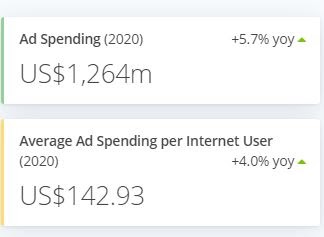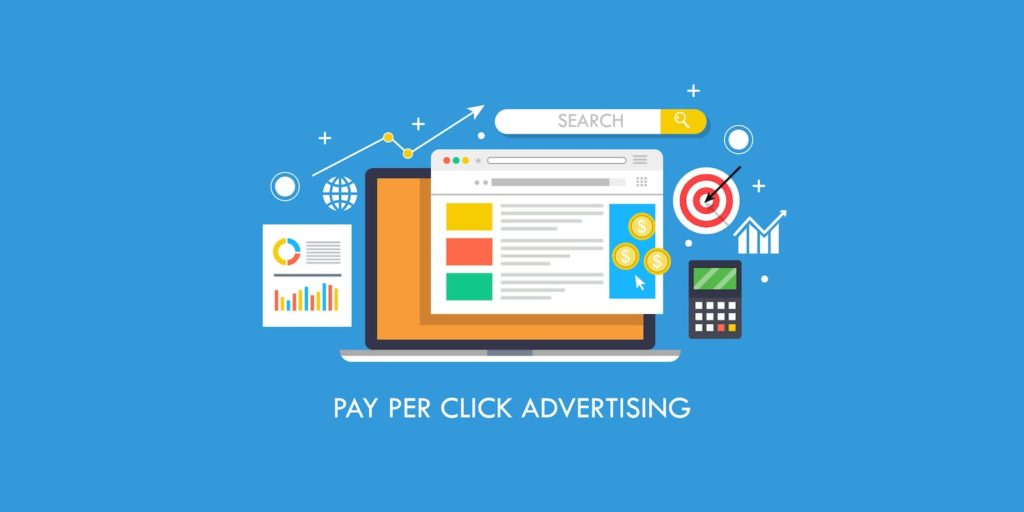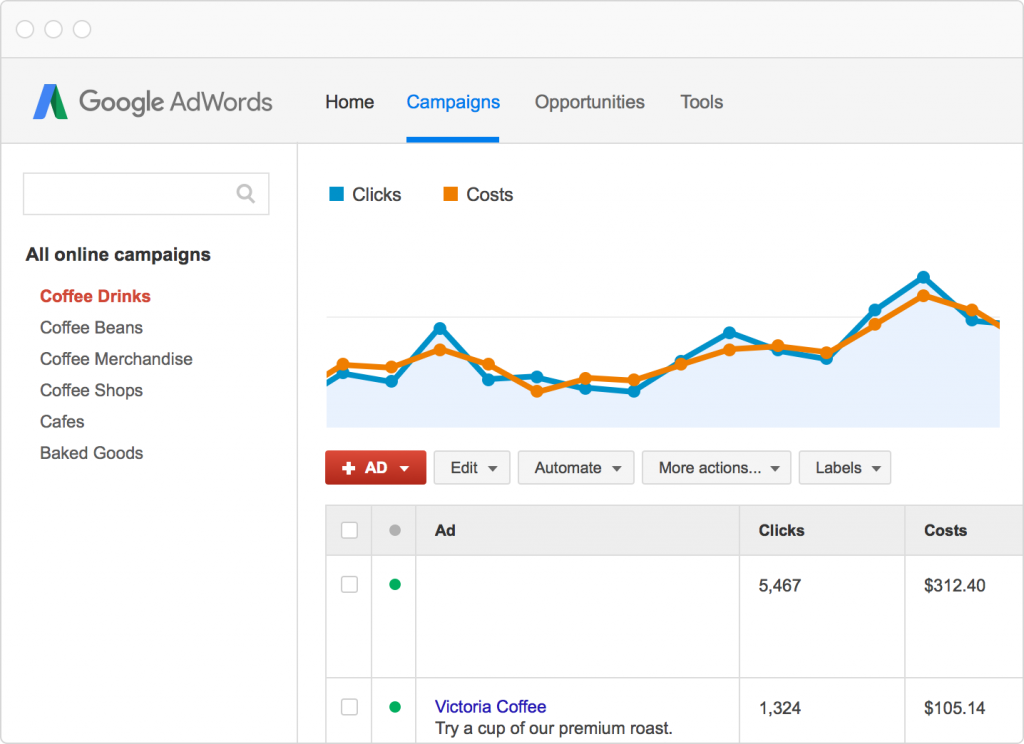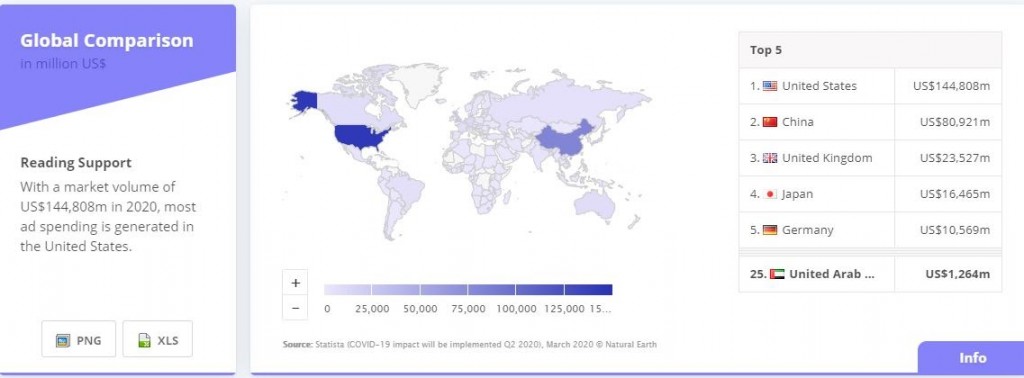Understanding the Complex World of Pay-Per-Click Advertising
May 1, 2020
Article Overview
10min read
The marketing world, and advertising as we know it, has undergone a major shift and change. Businesses now have the option to market their brands quicker, easier and more efficiently through the power of online marketing. One of the most popular advertising methods is pay-per-click, otherwise known as PPC. In the following, we will answer some of the common questions related to PPC.
Businesses invest in different types of advertising avenues. In the below image, you’ll be able to view the statistics of spending behaviors across various types of advertisements, such as video, social media, banner ads, search advertising and even classifieds.
What is PPC?
Advertisers can now showcase their products using search engines. Whenever a user clicks on these online ads, the advertiser has to pay the search engine. This is known as PPC marketing: an invaluable tool for businesses and can help increase traffic to a website and also generate leads.
You may have noticed advertisements on the top or right side of a search page or even on websites whenever you search for companies and the services they provide. These are paid advertisements that could include any of the popular types of PPC advertising models.
It is important to note that businesses running advertisements are only charged when a user clicks on their ad; hence, the name pay-per-click.
Businesses that consider investing in PPC will have to ensure to research and choose the right path based on their budget. This can help them take the necessary steps to ensure their brand stays ahead of their competitors. Over the years, businesses have focused on ad spending; this can help provide an insight into how essential advertising is.

An average user spends almost 2 hours and 24 minutes on social media itself. The overall time being spent on the internet is much more! This increases the rates of conversion and could help gain revenue for your business.
The following section focuses on the types of PPC advertisements to help potential advertisers to understand which type would suit best for their business.
What are the different types of PPC advertising campaigns?
There are 8 popular types of PPC campaigns; these include:
Shopping advertisements

This type can prove to be effective mainly for eCommerce websites. A Google Shopping campaign can help showcase your products in a carousel above the main Google search results. This can effectively be considered as an online shop window as it allows potential customers with a sneak peek of the price and products being offered before even accessing a particular website.
This type of PPC advertising has a higher chance of converting every click as the user will check your website after having checked the product on offer.
Search advertising
Search advertisements are the most types of PPC that can be seen on search engine pages, especially on Google. These adverts appear whenever you search for something on the top and bottom of the organized results. They can be identified with the small “Ad” tag next to it.
Businesses can advertise using this method by entering an Ad Auction held by search engines. In the case of Google, advertisements are curated and organized using the AdWords interface; this helps you source keywords and create targeted campaigns to feature your ads on relevant pages which can, in turn, help drive traffic for your business. This type of PPC advertisement is a proven way of achieving great results.
Social media advertising

Connecting with customers socially is another great way of marketing your goods. After conducting research about your target audience, you will be able to determine the right social media platform to be used for your adverts. According to a recent survey, it was found that users spend an average of 2 hours and 24 minutes per day on social media. If you place your advertisements on their newsfeed or social hangouts, the chances of click conversions increase greatly.
You would only require an account and not need a large social media presence to feature your ads on these platforms. You can create advertisements for most social platforms, but the main ones that could help increase conversions are Facebook, Instagram, Twitter, and LinkedIn. With a defined advertising strategy, you can increase your brand awareness among many users.
With this type of PPC advertising, you can share pretty much anything. You can either redirect users to landing pages or lead generation forms or simply highlight a piece of content you would want to be viewed. But, in order to execute this flawlessly, you must ensure to create relevant and engaging images and content; this will help attract users to click on your ad.
Display advertising
The examples of display advertising here appear on the top side and bottom right side of the page*
This type of PPC advertising showcases your adverts across relevant third-party partner websites on search engines. The process for targeting a specific audience with display advertisement differs slightly from that in the case of search advertising—using display advertising, you can target a specific group of audience to view your ads. This could include choosing relevant websites to feature your ads or a target audience who have visited similar websites as yours before.
This type of advertising method enables you to track who views your advertisement and where they are displayed. By creating engaging content using both image and text, you can increase brand awareness for your business across the internet.
Remarketing

Have you noticed an ad for the exact site or product you were looking at pop up when you visit another site? This means you’ve been remarketed to. This is an effective method of PPC advertising as it helps target people that have shown interest in your company or product. Seeing an advertisement for the same product or website might entice customers to revisit your website and convince them to make a purchase. This increases conversion rates for your website. Dynamic remarketing is especially effective as it shows users the exact product they were looking at on your website. This also helps keep users engaged with your brand.
Sequential remarketing

This is not all that different from remarketing but it’s often ignored. In this type of PPC advertising, you can create long-term campaigns that could show different content with time. Some common examples of sequential remarketing include pop-ups containing banners such as “Before you go, check out these offers” or “We miss you…” if you’ve stayed on a website for a long time without clicking any ads. This could help increase the conversion rate for your website.
Gmail-sponsored promotions

You can reach out to interested leads directly to your target audience’s inbox. These promotional advertisements appear at the top of a user’s inbox. Although they look like a general email but have an “ad” tag next to the subject line. These ads are available on both desktop and mobile formats.
Local service ads

A local service ad is one of the most popular types of PPC advertisements. However, this option is available only to a few markets such as plumbers, HVAC companies, locksmiths, electricians, and garage door companies. These could appear in a separate format as compared to traditional Google advertisements. They will appear with reviews and a brief description when a user looks up a type of service that falls in your business field.
What are the benefits of using PPC for a business?

If you’re still unsure if PPC advertising is what your business needs, you can check out some of the popular benefits of PPC.
PPC helps contribute to business goals
PPC can help a business achieve a variety of business and marketing goals ranging from a high-level brand exposure and thought leadership to eCommerce sales to generating traffic and leads to your website. PPC can prove to be a powerful tool to strategizing and tracking website traffic, supporting the sales, building awareness and helping gain customers. With the effective use of content marketing and thought leadership, PPC can pave the way to help increase conversion rates by using factors such as sourcing keywords, newsletter signups, contest entries, and even push for app downloads.
PPC advertisements can be measured and tracked
Keeping a track and measuring the performance of your PPC advertisements can be quite beneficial for a business. One of the best tools a business can use is Google Ads in combination with Google Analytics. With the help of these tools, you will be able to check the performance of your PPC ad campaigns with detailed statistical data and even check the number of impressions, clicks, and conversions. It also helps you understand the traffic and results being delivered for your budget and goals.
When you use Google Analytics to review your PPC traffic to dedicated landing pages and track it to conversion, you will be able to view the amount being spent and how it affects your business’ overall goals. This helps you stay updated about the entire timeline of your PPC ad campaigns.
Quick update and entries
If you’re stepping in today’s competitive PPC marketing, using the right PPC tool makes a huge difference. The right tool will help you create an account efficiently, research for your marketing campaign, generate content, source keywords that could help feature your ads, track customer conversion, and much more with a little bit of optimization. The more you learn about the PPC tool you intend to use based on your budget, the more efficiently and quickly you’ll be able to create a marketing campaign.
Have control over your campaign
Using a PPC tool will help you have control over certain factors related to how you can market your brand. It can start with using the right keywords, placement, or PPC ad type to target potential customers.
You can also control the budgetary aspects using an efficient PPC tool, including setting your own ad budget and bids and even choosing the amount you would be willing to spend. However, it is important to note that you would have to pay the market rate—or at least close to it—when bidding. The ad auction by Google Ads and its algorithm has the final say as to where your ads will be placed and what amount you’ll need to spend as compared to your competitors. The flexibility to edit and optimize your ad as per the ongoing trends and even trying new tests almost every day adds to the benefits of using a PPC marketing model.
A better solution to traditional marketing methods
Content rules the world of digital marketing. Using content plans and calendars are quite essential for every business. Pushing for engaging content based on the sourced keyword can help support the increase in conversion of a customer’s buying cycle.
Using keyword-based SEO content to showcase your ads can also increase the rates of customers clicking on your website and even leading up to click conversions. Using the PPC advertising model proves to be a cheaper alternative as compared to traditional marketing methods as it helps access real-time data and even track the trends among your target audience.
Multiple targeting options
Using the right PPC tool is essential to be able to spread your brand awareness among a large group of users. Using the services offered by the PPC tool being used, you can reach out to a newer group of audiences who weren’t among your company’s existing followers and even those who had no exposure to your brand. You can accordingly ensure full coverage across different social media mediums and even partner websites to run your ads and build a stronger following.
You will be able to access your marketing data, content calendar, performance features and much more and basically streamline the whole process using a PPC advertising model for your business. It is an invaluable medium to create a reliable and profitable channel for B2B, B2C, non-profits, and other types of companies.
Steps for creating a PPC campaign

Although important marketing aspects such as content marketing or SEO may take some time to fall in place, it could be cost-effective even if it’s outsourced. However, as per a survey, it was found that almost 70% of business owners preferred to focus their budget towards PPC advertising campaigns. This comes as no surprise as almost 64% of consumers on Google tend to click on the different types of ads featured when shopping online.
Another major reason for using PPC is the immediate results that can come from it; if strategically crafted, PPC ad campaigns can provide traffic, leads, and customers to your website almost instantly after the ads start running.
In order to understand how to create a successful PPC campaign, it is important to consider the major steps involved in it.
Conducting research
Researching various aspects such as keywords, trends, and the correct platform to use for advertising your company’s brand. As things are always changing in the world of PPC advertising, it’s important to stay on top of these changes in order to make the necessary modifications to your campaigns.
You can always consider hiring the services of a consultant or an agency to guide you through the complex process of PPC ad campaign management; this will basically help you ease the weight of managing the marketing aspect for your company.
Choosing the right PPC tool
There are many popular tools available in the market that can help you create a PPC campaign. Although Google Ads is one of the most popular choices, other choices such as SEMRush, SpyFu, Google Trends, and so on can help you execute some of the time-consuming processes (sourcing keywords, researching trends, and finding details about your competitors ad campaigns) can be done in no time.
You can bid on the popular keywords and even check their popularity using such tools; this can be followed by relevant content generation for your company.
Keywords and bidding
When creating an ad campaign for PPC, it is important to know the keywords that you would need to bid on. Using the right PPC tool can help you check the popularity of a particular keyword over a period of time. This can help you find relevant keywords for your business’ marketing model.
After these have been chosen, you should ensure to bid on these through the ad auction. You should ensure to check your budget for this; the right choices will help determine the return on investment as well.
Creating engaging copies
Once you have bid on the keywords, you will be able to create engaging and relevant content for your business. Using text, images, and even video will decide the rate of conversion that would help drive revenue to your website. Choosing the right format based on the right PPC network provider and your target audience will help you increase the quality score of your campaign.
Maintaining commendable PPC quality scores
An advertiser’s quality score is quite essential. Google states that the quality score is an aggregate estimate of the overall quality of your ads, use of keywords, click-through rate, and the relevance of the age and landing page. The higher the quality score is, the better the ad positions will be.
Auditing your existing PPC campaigns
Every field requires you to check and recheck your work. The same is with advertising; since, the internet is updated almost every second, performing occasional audits of your existing PPC campaigns will help in the long run. This can help your company perform better and, in turn, save money. It is always helpful to reevaluate your search and strategies that could fit current situations and market patterns when targeting your audience group.
Monitoring your results
You should ensure to periodically check the results generated from your PPC ad campaign. If needed, make changes as you notice any discrepancies in order to generate traffic to your site.
Popular PPC tools to choose from

Google Ads is one of the most popular PPC tools available in the market. It can help you form a strategic process to go about creating a PPC ad campaign for your business. Besides one of the best tools in the market, we have listed some of the efficient PPC tools available in the market today.

This is one of the best SEO tools available in the market. Although it is primarily known as an SEO tool, it has many PPC functions. This software helps you research your competitors’ ads, check the keywords they are bidding on, and even check their main sources of traffic. Ahrefs also has a large database of keywords which is perfect for keyword research. You can not only find LSI and related keywords but also arrange them based on volume, price, and difficulty level. It can also show you how much traffic for the given keywords comes from organic and paid searches.
Ahrefs allows you to conduct your own PPC research but also keeps track of your competitors in the market. Any new ad or campaign run by your competitors will show up and keep you updated.

This tool is quite powerful but underutilized when it comes to PPC marketing. It allows you to check the ongoing trends around the world at any given time; moreover, it also acts as a market research tool that can help you find profitable PPC keywords. Google Trends shows you the popularity meter from 1 to 100 for a particular keyword; it also shows the historical popularity and whether it’s on the rise or decline in current trends.
Google Trends also shows keywords that have gained an increase in searches over the past days, weeks, or months. This is great and quite helpful to stay updated and accordingly create content that could increase traffic to your website before your competitors.

As the name probably suggests, you can use this software with a massive database to track and record the PPC ads and keywords being featured by your competitors. It not only is quite useful but can also help you save a lot of time when creating your own ad campaign.
Your competitors, who were already running ads in the market before you, will have spent a long time researching the keywords, optimising their headlines, and even working on their landing pages. With detailed information about this, you can use all of it to your advantage. This app also lets you see the keywords your competitors are bidding on and even access the ads a business has run over the timeline of their campaign. This can help you launch your ad campaign with a little help from your competitors themselves!

This application has many features that are similar to those of Ahrefs. It has its own keyword research tool and PPC admonitor. SEMRush can help you save plenty of time by analyzing ads by your competitors and finding profitable keywords. It is a great alternative if you don’t prefer using other similar applications.
With in-depth research against your competitors and creating a well-defined plan, you will be able to ace the world of PPC advertising. Although it may take some time to show structured results, you can always work towards analyzing the performance of your ad campaigns with real-time data and modify it to fit future campaigns. A reliable PPC model can help drive up the sales, conversions, and traffic to your business’ website.


 +971 52 312 2506
+971 52 312 2506









